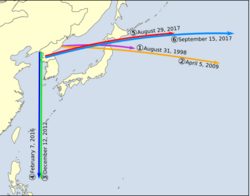Engineering:Kwangmyŏngsŏng-4
| Mission type | Earth observation Technology |
|---|---|
| Operator | NADA |
| COSPAR ID | 2016-009A |
| SATCAT no. | 41332 |
| Mission duration | 4 years (planned) |
| Spacecraft properties | |
| Dry mass | 150 to 200 Kilograms[1] |
| Start of mission | |
| Launch date | 7 February 2016, 00:30 UTC |
| Rocket | Kwangmyongsong |
| Launch site | Sohae Space Center |
| Orbital parameters | |
| Reference system | Sun-synchronous orbit |
| Regime | Low Earth |
| Perigee altitude | 465 kilometres (289 mi) |
| Apogee altitude | 502 kilometres (312 mi) |
| Inclination | 97.5 degrees |
| Period | 94 minutes, 24 seconds |
| Kwangmyŏngsŏng-4 | |
| Chosŏn'gŭl | 광명성―4호 |
|---|---|
| Hancha | 光明星4號 |
| Revised Romanization | Gwangmyeongseong-4 ho |
| McCune–Reischauer | Kwangmyŏngsŏng-4 |

Kwangmyongsong-4 (Korean for 'Bright Star-4 or Lodestar-4') or KMS-4[2] is a reconnaissance satellite launched by North Korea on 7 February 2016.
The launch happened after North Korea conducted a nuclear test on 6 January and as the United Nations Security Council was deciding on sanctions to be placed on the country following the nuclear test. The launch was also timed to celebrate the 74th birthday of the late leader Kim Jong-il on February 16.
Pre-launch
On 2 February 2016, North Korea sent a notification to the International Maritime Organization stating that the country was going to launch a Kwangmyongsong earth observation satellite with a launch window of 8–25 February between 22:30 UTC and 03:30 UTC given. The notification also included the drop zones for the first stage, the payload fairing and the second stage of the rocket, which was similar to the areas designated for the launch of Kwangmyongsong-3 Unit 2.[3]
On 6 February 2016, North Korea sent another notification to the International Maritime Organization stating that the launch window had been changed to 7–14 February.[4]
Launch

The satellite was launched on 7 February 2016 at 00:30 UTC into roughly a sun-synchronous orbit well suited for an earth observation satellite,[5] using an Unha launch vehicle[6] at Sohae Space Centre in Cholsan County, North Phyongan Province.[7] Regarded as sending a message to both neighboring China as well as the United States , the launch also took place on the eve of the Chinese New Year and the Super Bowl in United States .[8]
It was initially claimed by U.S. officials that the satellite was "tumbling in orbit" and that no signals had yet been detected being transmitted from it.[9] However, it was later reported the tumbling had been brought under control and the orbit stabilized.[10] This indicates that the satellite has established communication with North Korea.
The head of the U.S. Army Space and Missile Defense Command stated that Kwangmyongsong-4 was almost twice as large as Kwangmyongsong-3, and South Korean officials estimated the mass as 200 kilograms (440 lb).[11]
On February 22, Russian news agency TASS reported the statement by Colonel Andrei Kalyuta of Russia's National Space Monitoring Center that, based on the orbit of the satellite, it was in line with the declared purpose.[12] Satellite tracker and astronomer for Leiden Observatory Marco Langbroek captured images of the satellite on February 28; on examining long exposure images, the satellite was either not tumbling or in a very slow tumble. This was also evident by the stability of the brightness of the Sun's reflection when the satellite passed the camera frame.[13][14] Bob Christy of Zarya website shared results of observing orbital periods of the satellite, it indicated the satellite was not tumbling and was under control as controlled reduction in altitude of the orbit was detected.[15][16] North Korea Tech, an affiliate of 38 North, reported on findings made by Langbroek and Christy.[13] Harvard-Smithsonian Center for Astrophysics Jonathan Mcdowell concluded satellite was at least partially operational based on visual information and observation of the satellite's gravity boom being deployed.[17]
Post-Launch
North Korea registered the satellite with the United Nations Office for Outer Space Affairs on May 9.[18]
In addition to claiming North Korea was planning a moon mission, Hyon Kwang-il, director of the scientific research department at NADA, said the satellite had completed 2,513 orbits and had transmitted 700 photographic images in the day following its launch.[19] The satellite passes over North Korea four times a day and continues to transmit data.[needs update] However, international experts, such as astrophysicist Jonathan McDowell, have not confirmed any transmissions from the satellite.[19]
In May 2017, North Korea released satellite images of THAAD site in Seongju county, South Korea.[20]
Reactions

The North Korean government organized a fireworks display on February 7, 2016, in commemoration of the launch.[21]
South Korea, Japan, the United States and other countries have accused North Korea of testing a ballistic missile (Unha is the satellite launch version of Taepodong-2) capable of hitting the United States.[6][22] However, some experts at the time believed North Korea was still a decade away from having the capability to successfully deliver a nuclear weapon by means of an intercontinental ballistic missile (ICBM), and the launch showed slow, but continuous, progress.[23] The director of the U.S. Missile Defense Agency stated the launch was not a test of an intercontinental ballistic missile.[10]
The launch was strongly condemned by the UN Security Council.[24][25][26] It prompted South Korea and the United States to announce that they would explore the possibility of deploying Terminal High Altitude Area Defence (THAAD),[27][28] an advanced missile defence system, in South Korea, which is strongly opposed by China [29] and Russia .[30]
See also
- 2016 in spaceflight
- List of North Korean Missile Tests
References
- ↑ "Status of North Korean Satellite unknown after prolonged Radio Silence, Reports of Tumbling". http://spaceflight101.com/status-of-north-korean-satellite-unknown-after-prolonged-radio-silence-reports-of-tumbling/.
- ↑ "Technical details for satellite KMS-4". http://www.n2yo.com/satellite/?s=41332.
- ↑ "Launch notification reveals rocket drop zones - North Korea Tech". https://www.northkoreatech.org/2016/02/03/launch-notification-reveals-rocket-drop-zones/.
- ↑ "All systems go? DPRK brings forward launch window - North Korea Tech". https://www.northkoreatech.org/2016/02/07/all-systems-go-dprk-brings-forward-launch-window/.
- ↑ John Schilling (9 February 2016). "North Korea's Space Launch: An Initial Assessment". 38 North (U.S.-Korea Institute, Johns Hopkins University School of Advanced International Studies). http://38north.org/2016/02/jschilling020816/. Retrieved 10 February 2016.
- ↑ 6.0 6.1 Ju-min Park; Jack Kim (7 February 2016). "North Korean rocket puts object into space, angers neighbours, U.S.". Reuters. http://uk.reuters.com/article/northkorea-satellite-idUKKCN0VG04Z. Retrieved 7 February 2016.
- ↑ "DPRK announces successful launch of Kwangmyongsong-4 satellite - CCTV News - CCTV.com English". http://english.cntv.cn/2016/02/07/ARTI98lx135UGjmMIJwXw1FB160207.shtml.
- ↑ North Korea's 'successful' satellite in orbit - ARS Technica, 2/10/2016, 12:41 AM
- ↑ North Korean satellite "tumbling in orbit," U.S. officials say - CBSnews.com, 8 February 2016
- ↑ 10.0 10.1 Andrea Shalal; David Brunnstrom (10 February 2016). "North Korea satellite in stable orbit but not seen transmitting: U.S. sources". Reuters. https://www.reuters.com/article/us-northkorea-satellite-orbit-idUSKCN0VI1XN. Retrieved 10 February 2016.
- ↑ David Brunnstrom (11 February 2016). "North Korea satellite not transmitting, but rocket payload a concern - U.S.". Reuters. http://uk.reuters.com/article/uk-northkorea-satelitte-missiledefense-idUKKCN0VJ2PF. Retrieved 15 February 2016.
- ↑ "ТАСС" (in ru). http://special.tass.ru/politika/2688450.
- ↑ 13.0 13.1 "North Korea's new satellite caught on camera" (in en-US). North Korea Tech - 노스코리아테크. 2016-03-03. https://www.northkoreatech.org/2016/03/03/north-koreas-satellite-caught-on-camera/.
- ↑ "North Korean Satellite stabilizes in Orbit, Reports of Satellite Operation remain unconfirmed – Spaceflight101" (in en-US). http://spaceflight101.com/north-korean-satellite-stabilizes-in-orbit-reports-of-satellite-operation-remain-unconfirmed/.
- ↑ "Kwangmyongsong 4 Orbital Decay". http://www.zarya.info/Diaries/NKorea/Kwangmyongsong4ndot2.php.
- ↑ "North Korea claims satellite is transmitting images | NK News - North Korea News" (in en-US). NK News - North Korea News. 2016-04-07. https://www.nknews.org/2016/04/north-korea-claims-satellite-is-transmitting-images/.
- ↑ "N.Korean satellite sending songs, other signals to earth: media | NK News - North Korea News" (in en-US). NK News - North Korea News. 2016-03-10. https://www.nknews.org/2016/03/n-korean-satellite-sending-songs-other-signals-to-earth-media/.
- ↑ Byrne, Leo (27 May 2016). "North Korea Registers Satellite with UN". NK News. https://www.nknews.org/2016/05/north-korea-registers-satellite-with-un/.
- ↑ 19.0 19.1 "AP Exclusive: North Korea hopes to plant flag on the moon". Associated Press. 4 August 2016. Archived from the original on 20 August 2016. https://web.archive.org/web/20160820032940/http://www.msn.com/en-us/news/world/ap-exclusive-north-korea-hopes-to-plant-flag-on-the-moon/ar-BBvePu4?li=BBnbcA1. Retrieved 4 August 2016.
- ↑ "Yonhapnews Agency - Mobile" (in en). http://m.yna.co.kr/mob2/en/contents_en.jsp?cid=AEN20170510009000315&site=0400000000&mobile.
- ↑ Ellis, Ralph; Kwon, K.J.; Ap, Tiffany; Hume, Tim (8 February 2016). "North Korea celebrates satellite launch with fireworks display". CNN.
- ↑ Ralph Ellis, K.J. Kwon and Tiffany Ap, CNN (6 February 2016). "U.S., other nations condemn North Korean rocket launch - CNN.com". CNN. http://edition.cnn.com/2016/02/06/asia/north-korea-rocket-launch-window/. Retrieved 7 February 2016.
- ↑ Jack Kim; David Brunnstrom (9 February 2016). "North Korea turns to 'old workhorse' rocket to repeat past success". Reuters. http://uk.reuters.com/article/uk-northkorea-satellite-technology-idUKKCN0VI0M7. Retrieved 9 February 2016.
- ↑ "UN Security Council vows new sanctions after N Korea's rocket launch". https://www.bbc.co.uk/news/world-asia-35518058.
- ↑ "U.N. Security Council condemns North Korea launch - CNN.com". http://www.cnn.com/2016/02/07/asia/north-korea-rocket-launch-window/index.html.
- ↑ Gayle, Justin McCurry Damien; agencies (2016-02-07). "North Korea rocket launch: UN security council condemns latest violation" (in en-GB). The Guardian. ISSN 0261-3077. https://www.theguardian.com/world/2016/feb/07/north-korea-launches-long-range-rocket-it-claims-is-carrying-a-satellite.
- ↑ "China worried over US-South Korea plans to deploy THAAD missile system - The Economic Times". http://economictimes.indiatimes.com/news/defence/china-worried-over-us-south-korea-plans-to-deploy-thaad-missile-system/articleshow/50892130.cms.
- ↑ "Korea says THAAD 'helpful' to security". http://www.koreatimes.co.kr/www/news/nation/2016/01/205_196787.html.
- ↑ "North Korean rocket puts object into space, angers neighbours, U.S." (in en-GB). http://uk.reuters.com/article/uk-northkorea-satellite-idUKKCN0VG00L.
- ↑ Diplomat, John Power, The. "Russia: Korean THAAD Deployment Is a Security Threat". http://thediplomat.com/2015/04/russia-korean-thaad-deployment-is-a-security-threat/.
External links

